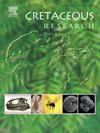Angiosperm radiation, diversification, and vegetation shifts through the Albian–Cenomanian of the northern Iberian Peninsula: Palynological evidence from the Las Loras UNESCO Global Geopark
IF 1.7
3区 地球科学
Q1 GEOLOGY
引用次数: 0
Abstract
During the mid-Cretaceous (Aptian–Turonian), angiosperms diversified and expanded their range significantly, but were potentially affected by several environmental crises. The Iberian Peninsula is particularly relevant to studies of paleobotanical events through this interval owing to its intermediate position between Gondwanan and Laurasian floral provinces and its wealth of assemblages containing early angiosperms. The Las Loras UNESCO Global Geopark is a unique area for paleobotanical studies of the mid-Cretaceous in the Basque-Cantabrian Basin, which currently has a depauperate record of floral evolution through this interval. Our palynostratigraphical results have clarified the chronostratigraphic positions and improved correlation of various formations in the Las Loras region. These results assign the Escucha Formation to the lower–upper Albian, the Santa María de las Hoyas Formation to the middle Cenomanian with diachronous (upper Cenomanian) deposits towards the west, and the Abejar Formation to the lowermost upper Cenomanian. Our new paleoecological results and a review of previous palynological data reveal notable changes in plant communities in the Iberian Peninsula through the Albian–Cenomanian. A conifer-dominated flora prevailed through the early–middle Albian but a shift to more diverse communities with increased presence of angiosperms typified the late Albian–early Cenomanian. The middle Cenomanian was characterized by conifer dominance but with expanded angiosperm diversity marked by the first occurrence of the Normapolles group. Finally, the late Cenomanian featured sporadic dominance by angiosperms, particularly the Normapolles group, in deposits associated with the Oceanic Anoxic Event 2.
伊比利亚半岛北部Albian-Cenomanian的被子植物辐射、多样化和植被变化:来自拉斯洛拉斯联合国教科文组织世界地质公园的孢粉学证据
在中白垩纪(阿普梯—土尔onian),被子植物的多样性和分布范围显著扩大,但也受到了一些环境危机的潜在影响。伊比利亚半岛位于Gondwanan和Laurasian植物省之间,拥有丰富的早期被子植物组合,因此对这一时期的古植物学研究尤为重要。拉斯洛拉斯联合国教科文组织世界地质公园是巴斯克-坎塔布里安盆地中白垩纪古植物学研究的独特区域,目前该地区有这一时期植物进化的详细记录。我们的孢粉地层研究结果明确了拉斯洛拉斯地区各地层的年代地层位置,提高了各地层的对比。这些结果将Escucha组划分为下-上cenomian, Santa María de las Hoyas组划分为中Cenomanian,向西为历时(上Cenomanian)沉积,Abejar组划分为上Cenomanian的最下部。我们的新古生态学结果和对以往孢粉学数据的回顾表明,伊比利亚半岛的植物群落在Albian-Cenomanian期间发生了显著的变化。在阿尔比尼亚早期-中期,以针叶树为主的植物区系占主导地位,但在阿尔比尼亚晚期-塞诺曼尼亚早期,被子植物的数量增加,群落更加多样化。Cenomanian中期以针叶树为主,但被子植物多样性扩大,以Normapolles类群的首次出现为标志。最后,在与海洋缺氧事件2相关的沉积物中,盖诺曼尼亚晚期的被子植物,特别是Normapolles群,具有零星优势。
本文章由计算机程序翻译,如有差异,请以英文原文为准。
求助全文
约1分钟内获得全文
求助全文
来源期刊

Cretaceous Research
地学-地质学
CiteScore
4.10
自引率
19.00%
发文量
235
审稿时长
12 weeks
期刊介绍:
Cretaceous Research provides a forum for the rapid publication of research on all aspects of the Cretaceous Period, including its boundaries with the Jurassic and Palaeogene. Authoritative papers reporting detailed investigations of Cretaceous stratigraphy and palaeontology, studies of regional geology, and reviews of recently published books are complemented by short communications of significant new findings.
Papers submitted to Cretaceous Research should place the research in a broad context, with emphasis placed towards our better understanding of the Cretaceous, that are therefore of interest to the diverse, international readership of the journal. Full length papers that focus solely on a local theme or area will not be accepted for publication; authors of short communications are encouraged to discuss how their findings are of relevance to the Cretaceous on a broad scale.
Research Areas include:
• Regional geology
• Stratigraphy and palaeontology
• Palaeobiology
• Palaeobiogeography
• Palaeoceanography
• Palaeoclimatology
• Evolutionary Palaeoecology
• Geochronology
• Global events.
 求助内容:
求助内容: 应助结果提醒方式:
应助结果提醒方式:


